Please take a look at our advertisers. They help us reduce the cost of maintaining our site!!!!
----------------------------------------------------------------------------------------------------------------------------------------------------------------------------------------------------------------------------------------------------------------------------------------------------------------
Welcome to VictorianSource.com™my website designed for Victorian architecture
lovers worldwide. This site contains hundreds of original photographs of Victorian homes taken during the latter part of the
19th and the very early 20th century. I have also tried to include descriptions of many of the homes' original owners to aid
in an understanding of the personality that the home might have. In addition pictures of street scenes, waterfront activity,
rail stations, events and first hand descriptions of life in general during this period are showcased.
Virtually all images are scanned from my personal collection. Over almost four decades, I have amassed
a historically significant collection of vintage postcards, long out-of-print books and pamphlets, advertisements, maps, documents
and original early photographs. Almost all images source from the Yonkers, New York area, a virtual treasure trove of Victorian
architecture and one of the most historic cities in America.
Today,
many fine Victorian homes still remain in the area, although sadly a significant number have been altered or demolished over the years. It is encouraging, however, to see much
preservation and restoration work in progress all over this beautiful city. In many cases, these architectural gems simply
await an owner with the resources, vision, and commitment to preservation
to peel off the layers of aluminum or vinyl siding that suffocate the hidden beauty underneath.
It is hoped that this website will be an invaluable tool for the restorer, historian, or lover of
Victorian architectural detail and splendor. Or maybe if you live in the Yonkers, New York area, you might be surprised to
see an early photograph of your own home on this site! Many have! You can visit http://VictorianSource.imagekind.com/ to purchase high quality images you see
on this website or contact me directly via the links included in the links section of this site.
In restoring my own Victorian era residence and from
my past tenure on the Yonkers Landmarks Preservation Board, I have come to know a number of truely knowlegable historians,
preservationists including several passionate Realtors whom you can trust to show you some of the true Victorian Era gems
that may be for sale. The realtors are listed on this site as well. Just so you know, I have listed them for free and there
is nothing gained in return other than the satisfaction and hope that the homes they sell will find a passionate new
owner who values restoration.
I have recently
expanded the scope of the site to include reference to the Colonial era as represented by Philipse Manor Hall in Yonkers,
as well as some post Victorian events of importance such as the incredible Hudson Fulton Celebration of 1909.
Now come sit back and enjoy an excursion into an era where craftsmanship, attention to detail and
beauty reigned. Please let me know if you have enjoyed my site. I have included a guest book on the home page in addition
to another guest book designed for comments on the "Then and Now" page. You can also follow on Twitter: VictorianSource
Now step back to a simpler time and explore this site.
You might want to first read about what one man recalled in 1922 about coming to Yonkers in
1876. You might also be interested in reading what one man said about preservation in an 1895 speech in Yonkers when the demolition
of Philipse Manor was being strongly considered. You might also be fascinated by the events of the Hudson-Fulton Celebration
of 1909 where more than 200,000 people were in Yonkers (at that time a city of less than 100,000) to witness the festivities.
Just click on the links that follow here.
One
final note, I have created this website for all to enjoy. Nothing prevents anyone from copying images and content, but if
you do, please include a reference back to this site when you post it wherever, so that others might enjoy what has been created
here. That is why I didnt include watermarks etc to take away from the photographs.
Please enjoy my website and feel free to comment or ask questions in the guest book sections.
I promise I will respond.
Bob Piwinski
Site Owner and Webmaster
VictorianSource.com
YonkersonHudson.com
Local Historian
Former
Member Yonkers Landmarks Preservation Board
CLICK HERE for recollections of Yonkers in 1876
CLICK HERE for Thoughts About Preservation spoken in Yonkers in 1895
CLICK HERE for photos and details of the Hudson-Fulton Celebration of 1909 in Yonkers.
CLICK HERE for a FREE INSTANT DOWNLOAD of Yonkers Historic Design Guidelines Book published by the Yonkers Landmarks Preservation
Board
A particulary insightful passage from the preface
to The History of Yonkers by Rev. Charles Elmer Allison, 1896:
And another from the New York Times:
"We will probably be judged not by the monuments we build, but by those we have destroyed."
- New York Times Editorial, Oct. 30, 1963
A Guestbook for our Visitors.
We'd be honored if you leave us a comment and sign our Book:


This photograph was taken from the Lake Avenue Water Tower in 1900 providing a Victorian era "aerial"
view. The beautiful Victorian home "Stone Gables" in the center located at 459 Palisade Avenue was owned by Theodore
H. Silkman, a then prominent attorney. You can read his obituary from the New York Times below. Sadly today the site
of Mr. Silkman's home is occupied by a condominium complex. The home at the bottom of the photograph as well as the home at
the left still exist today. The one on the left is in beautiful restored condition. For perspective,
the street that runs left to right is Palisade Avenue and the street that intersects it is Dudley Place. The orientation of
this photograph is looking northwest.

The 1907 map below illustrates the position of Mr. Silkmans property on Palisade Avenue.


Some insight into the character of Mr. Silkman from a 1902 Article in the New York Times.


An Autumn view from John
Bond Trevor's property circa 1880 from a StereoView Card. (Today it is the Hudson River Museum) Note the sailboat sailing
the Hudson River. The exposure time for the photograph was relatively long and the sails movement caused the bluriness.

In 1912 you could have bought this two family house in South Yonkers with $700 down. Note
the Realtor's phone number has only 3 digits!


The beautiful Victorian Residence of Margaret T. Stone located at 27 Lake Avenue on the corner of Lake and
Palisade Avenue. This photo dates to around 1901. Today there are two family homes on the property which was approximately
a half acre. The home in the distance is still there today!

A fascinating article from the New York Times published in 1879 about a Yonkers man celebrating his
100th birthday who recalls meeting George Washington as a boy growing up in Yonkers.
390 North
Broadway Yonkers photographed in 1901 - The Victorian mansion of James Renwick Brevoort
Noted
Hudson River School Painter. Take a look at his obituary from the New York Times posted below the photo of his residence.
You will note that the photos after these are of his next door neighbor's residence located at 352 North Broadway.
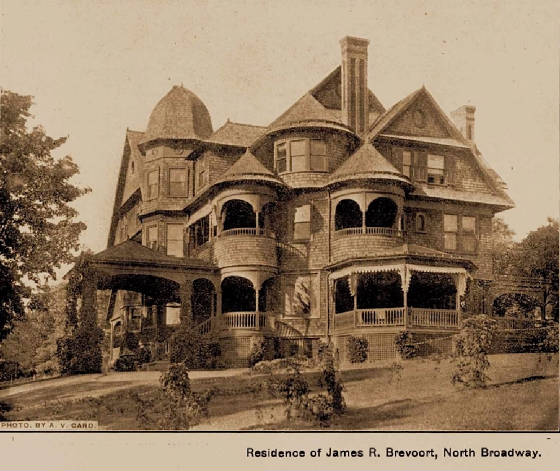

352 North Broadway in Yonkers - The magnificent Victorian Mansion of John Craig Havemeyer photographed
in 1901
This was the home of John Havemeyer in the early 1900's. He names his estate
"Robin Lawn". You can read his 1922 obituary (below the photograph and map) from the New York Times for some insight
as to who he was and what he did.



After the deaths of Havemeyer and Brevoort, The two mansions, Robin Lawn and The Glenwood lodge were purchased
by a group of investors who built a covered walkway between them, added several stone buildings and created an upscale boarding
establishment. Annie E. Lane was the director. Read this rare promotional brochure below which touts the beauty of the area
and showcases rare interior photos of these now long gone gems. Sadly, in the 1950's a great fire consumed Robin Lawn. Today
condominiums occupy the site.
The photo above is from the 1940's. A fire in the 195O's consumed the building and it was later torn town.
This magnificent example of Victorian architecture is long gone. The site is now occupied by condominiums.
The
rock wall and pillars remain to this day.
The Beautiful Victorian Residence of James
Gage Beemer located at 170 Shonnard Terrace in Yonkers, New York. Photographed Circa 1900. He named it "Ridgemont" This stone home was built in the early 1880's and has
seen several expansions that have given it a Castle like presence today. With priceless interiors from the 16th through 19th
century imported from Europe including original Stained Glass by Tiffany and LaFarge, it is almost 9,000 square feet today.
It has been magnificntly restored by its current owner, who has renamed it "Greystone Court". It is currently for
sale. (http://cityroom.blogs.nytimes.com/2011/06/03/big-deal-a-castle-in-yonkers-on-the-market-for-4-95-million/
) Read below about its first owner James Gage Beemer and all of his business and charitable associations. A
Fascinating life.
Map of 1907 showing 170 Shonnard Terrace
The Saegkill
Golf Club Yonkers New York as it appeared early in the 20th Century. The Golf Club consisted
of 22 acres and was located right across the street from what is now the parking lot to St. Johns Riverside Hospital on North
Broadway. The Golf Club was also the stage for a fascinating story that played out in the Yonkers Courts in 1901 where a prominent
citizen was arrested for playing golf on a Sunday! Read the story below.


The map above is from 1914. The location of the club house is clearly
marked. The street running north/south is North Broadway. The clubhouse was located approximately where the Medical building
and Chase Bank now stand at 984 North Broadway across the street from St. Johns Riverside Hospital. The map shows Duncraggan,
the home of Ms. Thomas (Anna) Ewing. She was the daughter of Eva Cochran who when she died in 1909 inherited the estate. The
property was later purchased by Samuel Untermeyer who expanded his estate. Interestingly
the "Duncraggan" entrance pillars still stand today on either side of the bus shelter in front of the hospital!






The Victorian Residence of John Savage Hawley. Mr. Hawley was a highly
successful businessman in the confectionary trade, a developer and another "Saint of Yonkers" who gave back to society
in many important and selfless ways. After witnessing a tragic accident, in 1896 he established an industrial farm school
for homeless wayward and neglected boys to teach them to become law abiding respectable citizens. (It still exists today)
Together with Charles Harriman, he built the Harriman train station (Greystone) for the convenience of local residents. Below
was his residence on Warburton Avenue. It is still in existence today!
The Forgotten
History of Ridge Hill. Alexander Smith Cochran's Magnificent
Gift of 110 acres plus a fully built hospital to the City of Yonkers in 1907. Read this amazing yet so tragic story......
CLICK HERE
Above: The Bronze Plaque that once hung on the now demolished hospital wall. It has been promised by the developer
that this plaque and its history will be memorialized within the new Ridge Hill Development.
The Magnificent
Yonkers, NY Victorian Residence of E. Bright Wilson in 1905 located at 240 Van Cortland Avenue. Mr.
Wilson was a prominent attorney in Yonkers. This home was built in 1896 in the Park Hill Section and today is in beautiful
restored condition.
In
1901 the cost of a commutation ticket to manhattan was $5.10 a MONTH. The average time was 32 minutes, no different than today,
time that is. There was even an option to have your own personal chair which you brought from home and the conductor kept
for you in the car! All you needed to do was provide a yearly tip! Late in 1901
the railroad decided it could make money on the practice, so it caused an uproar by levying an extra $10 YEARLY charge for
those who wanted their own personal chairs! (One has to wonder if we really have it better today!) Read the article below
for more insight! Below the article is a photo of a New York Central Train departing the Yonkers Train Station in 1889!


The
beautiful Victorian Residence of Halcyon Skinner on the western side of Hawthorne Avenue (between Downing Street and Highland
Avenue) in 1880. Halcyon Skinner was a brilliant inventor who revolutionized the carpet manufacturing
industry and whose contributions resulted in the Alexander Smith and Sons Carpet Company of Yonkers eventually achieving the
status of the World's largest carpet company. Read about his accomplishments below from a history published in 1899 a year
before his death in 1900. Mr Skinner was struck and killed by a train crossing the tracks behind his property on his way to
his boat. See his obituary from the New York Times below.


HALCYON SKINNER.
Yonkers resembles other cities in that some of its citizens, by reason of
political influence,
or wealth, or fluency of speech, have attained
prominence
for a brief time, and then
have been forgotten. Among those whose
distinction
is deserved, and not short-lived, is Halcyon Skinner. He came to
Yonkers in
1865, an unassuming stranger, neither wealthy
nor college-bred,
in dress plain, in manners quiet, in disposition retiring, a man of more
thought than words;
and those who met the unpretentious stranger did not
know that his labors
here would prove such an important factor
as they have
become in promoting the
growth and prosperity of the town,
and making it
famous at home and
abroad as a center of one of the largest
carpet industries
in the
world; nor did they know that his great ability
as an inventor would
materially increase the wealth of the country. Mr. Alexander Smith, his
friend and employer, appreciated his talent, and on more
than one occasion,
notably when
Messrs. A. T. Stewart & Company endeavored to secure his
services, he
made such arrangements with him that Mr. Skinner
remained_
with him.
The annals of
Yonkers would be incomplete without
a record of Mr.
Skinner's contributions of original thought to its development. His father,
Joseph Skinner, of New
England, was an inventor and natural mechanic,
whose tastes turned him away from farming, to which he had been bred, and
influenced him
to engage in mechanical pursuits.
Halcyon Skinner's early
education was obtained in
a log-cabin district school in Ohio,
and subsequently,
when the
family moved to Massachusetts, he attended school at
Stockbridge during several winters, working in summer for the neighboring
farmers, or for his father in the
shop. His father's success in devising and
constructing
machines for rapidly and efflciently
forming the various parts of
violins,
led him to the construction of
a large machine for cutting veneers,
and one of his father's large machines for
veneer-cutting was in use for some
years
in Mr. Copcutt's mill, at West Farms, New York. In
1838 the family
moved to West Farms, where the
father became foreman for Mr. Copcutt,
and the son worked with him in the
mill. When the mill was destroyed by
fire, in 1845, Halcyon Skinner found
work as a carpenter. He was then
twenty-one years
old. In 1849, when Mr. Skinner was about twenty-five
years of
age, Alexander Smith, who was owner of a small
carpet factory at
West Farms,
and who knew something about his mechanical skill, had a
conversation with him about a new method of dyeing
yarns, in which he and
an assistant were interested. The carpet
factory was not then in operation,
but Mr. Smith
and Mr. John G. McNair were engaged in
devising and
constructing some apparatus for parti-coloring
yarns for ingrain carpets. Mr.
Smith desired
Mr. Skinner to aid them. The object was to so
dye different
parts of
a skein of yarn that when woven into the
fabric each color would
appear in its
proper place in the design. If this could
be accomplished the
striped appearance, which was a great objection in
ingrain carpets, would be
avoided. The process
required reels of a particular form and a special
reeling
machine, also an apparatus for immersing parts of the skein in the dye
liquor accurately to a measured depth. Mr. Skinner overcame the difficulty
with which
the experimenters had met, and devised a reeling machine and
dipping apparatus which proved to be efficient. A factory
was built for manufacturing
the new style of
carpet on a large scale, and Mr. Skinner became
the general mechanic of the factory. When his connection
with the Alexander
Smith &
Sons Carpet Company terminated, in
November, 1889, he
had rendered Mr. Smith and his business successors a
service of forty years.
Only those
familiar with the history of carpet manufacture in the United
States and
abroad can begin to realize what Mr. Skinner accomplished.
The carpet
industry as he left it widely differed from what it was when he
became connected with it.
In
1855, when Mr. Smith spoke to him about the
possibility of constructing
a loom
for weaving Axminster carpet, that fabric was woven by a slow
and costly
process of hand weaving. It seems that no
attempt had ever been
made to
weave it in any other way. Mr. Skinner at that time knew little or
nothing about power looms of any
kind, and had not even seen a power loom
in operation
for many years. His tools were few, as were
the conveniences
with which
he had to work. The invention of the Axminster
loom was the
beginning of
a new period in the art of carpet-weaving, because it first made
possible the production
of this high-grade fabric by automatic machinery.
One operative
with the new loom could easily produce as many yards per day
as
seven or eight could produce by
the best previously known method. The
weaving of tapestry ingrain by power was also considered to be impossible,
until Mr. Skinner devised
machinery by which the work was efficiently done.
When looms for weaving
tapestry Brussels were brought to Yonkers
from
England and proved defective, Mr.
Skinner designed a loom so superior that
eventually the number of
yards of carpet produced by it was double the
number
manufactured by the imported loom in the same time. The English
looms were sold
for half what they cost to make room
for the improved ones.
"When the English yarn-printing machines
accompanying the looms were
found unsatisfactory, Mr. Skinner designed a new machine
as much superior
to the old one as
the new loom was to the imported loom. The printing
machines from
England were broken up.
In 1874
he received from A. T. Stewart & Company an offer of a much
larger salary than he was receiving
from the Smith Company, to enter their
service and take supervision of the
mechanical department of the various factories
which they controlled.
After careful consideration he decided
to remain
in Yonkers, and made an engagement with Mr. Smith for a term of
years.
Immediately after the engagement Mr. Smith broached to him the subject
of
getting up a power loom for weaving moquette carpets. Mr.
Skinner gave
his attention
to the matter and made some experiments, but as much of his
time was taken
up with planning buildings and other matters, it was
several
years before much progress
was made. In 1877 a patent was obtained
and half
a dozen looms were built. Two of these were sent
to England and
France, where several concerns were licensed to build and operate looms
under the patents which had been obtained in those
countries, and he spent
a number of months
there attending to the construction and
starting of them.
In 1879 forty looms
were built and put in operation by the Smith
Company.
From that time the manufacture of moquette carpets increased
as experience
and skill
were acquired in operating the looms,
and various improvements in
details were made, until one operator attending
two looms can weave from
twenty-five to thirty times as much in a given time as could be woven by one
working by the best methods known previous to the
invention of the moquette
power-loom. These and other very important
inventions did not engross all
Mr.
Skinner's attention. Much of his
time was occupied in oversight of the
general mechanical work of the
large factory, and in planning and superintending
the construction of the new buildings
which the expanding business
required. Having reserved the right to use
in looms for weaving body-Brussels
carpets the
improvements which he had made in tapestry
looms, Mr. Skinner,
in 1881, designed
for the Bigelow Carpet Company, of
Clinton, Massachusetts,
a loom
for weaving that class of goods. He prepared working drawings, and
a loom was built
at the works of the company, which proved so successful
that all
the looms put in operation after that time
were constructed after his
plans in preference
to those previously designed by
Mr. E. B. Bigelow, the
original inventor of the power looms for weaving
body-Brussels carpets. Mr.
Skinner's
rights in the subjoined list of patents were
assigned to Mr. Alexander
Smith, or to the
Alexander Smith & Sons Carpet Company:
I. Axminster
loom; 2, Improvements on Axminster loom; 3, Improvements
on ingrain loom;
4, Improved tapestry loom; 5, moquette loom; 6,
Improvements on moquette loom; 7, moquette fabric
(4 shot); 8, moquette
fabric (3
shot and 2 shot); 9, improved chenille carpet loom; 10, chenille (or
" fur
") loom.
When Mr. Skinner began working for Mr. Alexander Smith, in 1849,
the establishment
consisted of one small wooden building, containing nineteen
hand-looms
for weaving ingrain carpet. The looms were not then in
operation, but when in full work would turn
out about one hundred and seventy-
five
yards per day, making about a wagon load to
be sent to New York
each week. The
looms were all in use in the spring of 1850, when the new
method
of dyeing had proved a success. When Mr. Skinner left, in 1889,
after a
service of forty years, there was a series
of large brick buildings, with
floor room to
the extent of about three acres, all of which
had been planned
by Mr. Skinner and erected under his supervision. These buildings contained
at that date nearly eight hundred power-looms, the
more important and valuable
of which Mr.
Skinner had invented and designed, and the remainder
of which
he had so greatly improved that the production of each one of them
equaled
that of two of those used previous to his improvements. About
thirty-five
hundred operatives were employed in the various departments, and
the actual production of all kinds reached 9,217,000
yards per year. In
1892, three years
later, the production had increased
to 40,000 yards per
day, of which 15,000
yards were moquette, amounting to 4,500,000
yards
per year of that kind of carpet. In
1895 the number of looms of all kinds
had reached
930.
To show more fully the importance and value
of the invention of the
moquette loom, it may be said that the production above mentioned (15,000
yards per day) would
yield to the owners of the patents a royalty of
twenty
cents per yard, amounting to
nine hundred thousand dollars for the
year,
besides a still larger
amount in profits to the manufacturer. In addition to
this, the Hartford Carpet Company,
in this country, and several companies
in England
and France, were paying large amounts in royalties. The most
important result of the inventions of the moquette loom and auxiliary
machinery for preparing the materials is
the reduction in the price of this
very desirable
style of carpet from three or three and
a half dollars per yard
to considerably less than one dollar, thus bringing it within the reach of all
who care to have a carpet of any
kind. This difference in price, taking
the
quality produced by the Smith Company alone (say 15,000 yards per day),
represents a saving to the consumer of
nearly twelve million dollars a year.
The
quantity produced by other companies would greatly increase this amount.
Notwithstanding the small cost of manufacturing
this fabric, which was never
produced in this country before the invention of
the loom, the daily wages of
the
operatives are more than double those of the
workers under former
methods. These
statements help one to realize what Mr. Skinner has done
for Yonkers and for the country. Since
leaving the Smith Carpet Company^
he has been engaged
a considerable part of his time in designing and
constructing a new moquette loom,
which has shown a capacity for greatly increased production and
greater economy of material.
Having no
interest in the royalties or profits derived from his
former patents, he is at the present
time, at the
age of seventy-two years, with
the co-operation of a few
friends, making
preparations for manufacturing carpets in
the mill near Nepperhan avenue,
and at the
east end of the Glen.
Mr. Halcyon Skinner's two sons are both inventors.
In 1879 Charles
E. Skinner,
who had worked with his father in constructing
and putting in
operation the Axminster loom, and afterward on the moquette loom,
studied
out some devices by which he thought moquette goods could be woven
in a
way different from that in which the original
loom operated. Not being a
practical weaver,
he associated with himself Mr. Eugene Tymeson, who had
started many
of the moquette looms at the Smith works, and
was an expert
at that work. An
experimental loom was built which gave good results, and
a patent
was obtained. Arrangements were made by
which the patent, with
several others
afterward obtained, were transferred to the Smith Moquette
Loom Company, for the consideration of
one hundred thousand dollars in
stock.
Unfortunately for him the company did not prove a success and the
stock
proved to be of no value, the property being
transferred to the Alexander
Smith & Sons
Carpet Company. His improvements were not put in
operation as a whole, but some of them were
applied to the original moquette
loom,
with the result of a considerable increase in
production.
About 1881 Mr. Halcyon Skinner's second son, Albert L. Skinner, who
had been working for several years
in the machine shop connected with
the
Smith Works, a considerable part of
the time on looms, thought he could
do
something in the way of inventing a moquette loom. His ideas were
quite novel
and gave promise of good results if properly carried out. He
made drawings of some devices embodying his ideas, and obtained a patent
for
the same. He made arrangements with the Bigelow
Carpet Company,
of Clinton, Massachusetts, and
built a loom, which was put in operation at
their works. It proved very successful, and a large number of the looms
were built
and have been profitably operated by the
company ever since.

The 1893 Map below shows the location of his home. The residence is long gone and has been replaced by
a park as noted in the picture below the map.

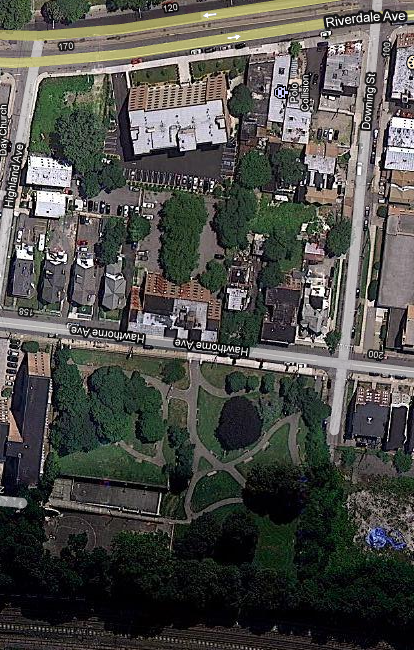
Jacob Read, one of Yonkers oldest and respected citizens in the late 1800's describes life in Yonkers from 1829 through
1895 when the interview below was written. He owned the Yonkers Sugar Refinery for 40 years before selling it
in the early 1890's. Mr. Read died in Yonkers, January 1899.










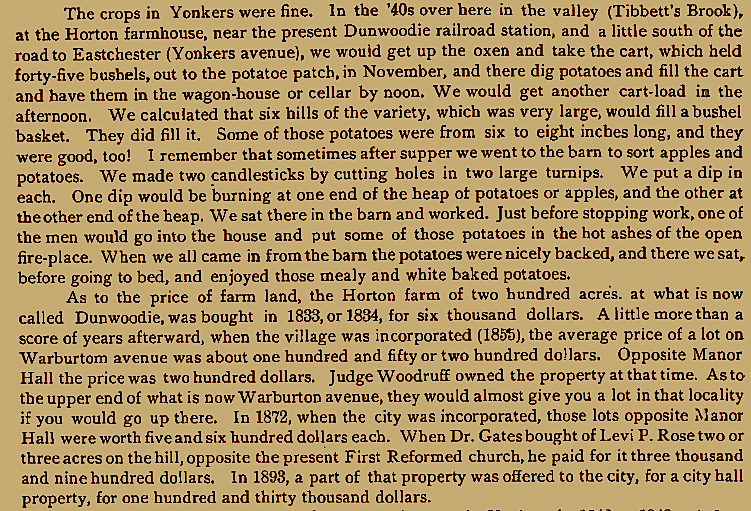
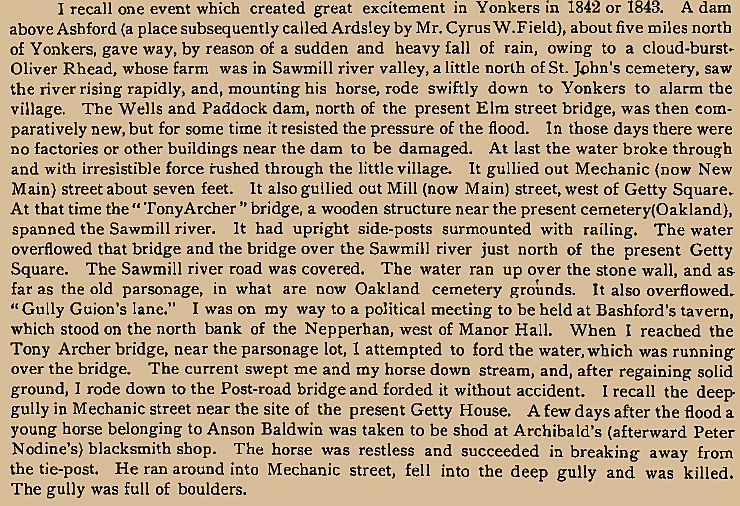
The
Alexander Smith and Sons' Carpet Company came to Yonkers in 1865 and at its peak was the largest carpet company in the world
employing over 7000 people. Read its fascinating history by clicking the link below this
photograph.

CLICK HERE to read about the History of the Alexander Smith Carpet Factory (once the largest carpet factory in the world),
the Moquette Row (the housing built for the workers) and the incredible contributions of the Smith and Cochran Families to
the City of Yonkers
287 Palisade
Avenue - The residence of Richard Edie Jr. and his wife, the former Priscilla Van Tassel as photographed in 1900.
Richard Edie Jr. was Treasurer and later Chairman of the Board of
the Alexander Smith Carpet Factory. He also served as President of the Yonkers Board of Education in the late 1920’s.
To this day, there is a scholarship still given to a graduating student of a Yonkers High School in his name.
He died of heart disease in September 1935 at the age
of 67. The carpet mills shut down and observed a moment of silence as he was laid to rest. Mrs. Edie died in September of
1947. The home was demolished in the 1960’s and is now the site of a multi-family apartment building.

240 Palisade Avenue - The
residence of Dr. Benjamin W. Stilwell as photographed circa 1901. The home was located on the
southeast corner of Palisade Avenue and Flagg Street. Read about the life of Dr. Stilwell below the photograph of his residence.

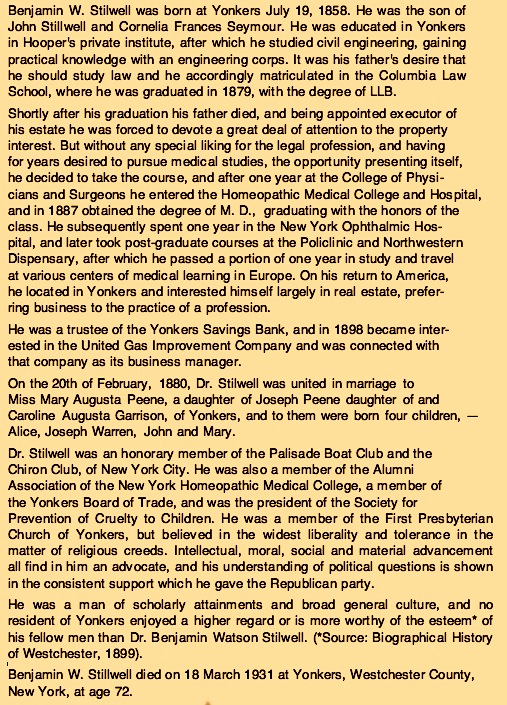
967 North Broadway - The home of Eva Smith Cochran photographed
in 1901
Eva Smith Cochran was one of the true patron saints of Yonkers, having given
so many institutions of the city more than $2,000,000 in lasting gifts. The Cochran name remains in many places in the City
of Yonkers, even to this day 101 years after her death in 1909. The Cochran's named their residence Duncraggan. The beautiful
Victorian home and estate was later sold by Eva's daughter to Samuel Untermeyer their neighbor on the south. Duncraggan at
that time was 22 acres. See below what the home looked like and read a little about this incredible woman. She is buried in
Oakland Cemetery in Yonkers in the most simple setting. Her estate was valued at the time of her death in 1909 at over 8 million
dollars. The mansion has long been demolished, but the stone pillars that once stood at the entry to the estate still bear
the Duncraggan name and still stand on either side of the bus shelter in front of St. Johns Hospital (This hospital was just
one of her gifts to Yonkers)!



Several pages from her Memorial Book:


Imagine purchasing what would become a treasured national landmark, restoring it and then presenting it
to the City of Yonkers as a gift!




Two portraits of Eva Smith Cochran from a privately printed Memorial Book published in 1911.

A small plaque that hangs in St. Johns Church in Getty Square. The words are powerful!

Eva Smith Cochran's simple gravesite in Oakland Cemetery, Yonkers
612 North Broadway, Yonkers NY Photographed in 1900.
At
that time the home was owned by Charles A. Fulton, a businessman. He and Theodore Heinrichs of Yonkers were partners in a
mining company. This home is a truly spectacular example of Victorian Craftsmanship. Stained and leaded glass, Curved windows,
superb stone work. It even has a matching horse stable in the rear of the property. This home and stable still exists today
in pristine original condition. Look at the "Then and Now" section of this site to see what it looks like today.


430 North Broadway in Yonkers - The Magnificent Victorian Residence of Charles Perceval Photographed
in 1900. The photos below show this residence in 1900. The second shows the home in 1905 as
it was placed for sale. There is a detailed description of the home and its features. Finally below this is a map from 1907
that shows its location on North Broadway. Today the site is occupied by garden apartments. Take a look at the then and now
section of this site.

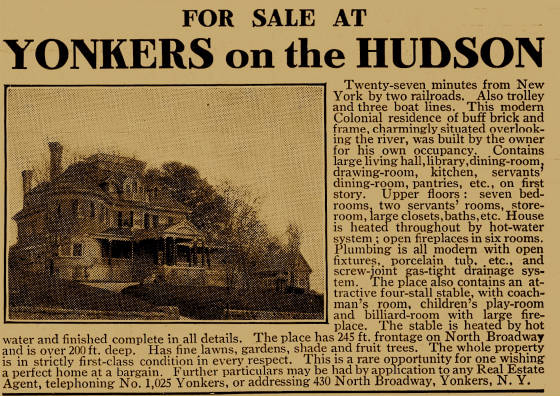

Here are
two early 1900's photos of 123 Valentine Lane in South Yonkers.
This was the home
of John T. Duff, a Yonkers real estate investor. Mr. Duff also had a hobby raising Chickens on his property. Take a
look at the "Then and Now" section of this website to see what this spot looks like today.
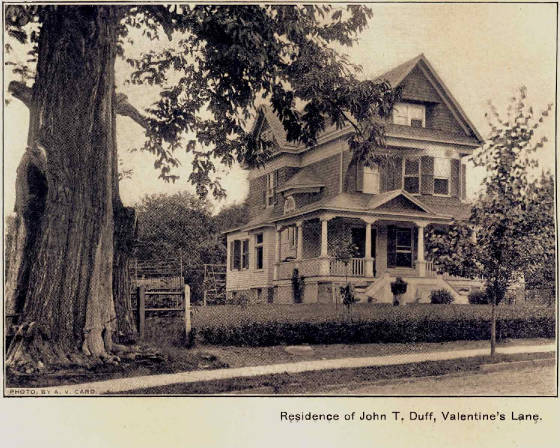

The photo above shows the homes of John T. Duff (extreme right) and Charles F. Cay along with some distant
views of more homes along Hawthorne Avenue circa 1903. The 1907 map below shows the location of these homes.

View from 147 North Broadway, Yonkers looking
West - Circa 1900
Photograph of the view from the back window of 147
North Broadway, then the home of Robert H. Neville, Yonkers circa 1900. To the left is the African Baptist Church (demolished).
The small street is Ashburton Place and in the distance on the right is the spire of the Warburton Avenue Baptist Church (demolished
in 1967).


The 1907 map shows the location and owners of the residences in the photo above this map.
Circa --1910 Hudson View Terrace homes newly built off North Broadway near Glenwood Avenue,
Yonkers, NY
These homes were listed with Christian Gaul, a local realtor/developer at
the turn of the last century. They are all still there today.

1904 Park Hill on the Hudson
- Miss Anne Brown's Highcliffe Hall - School for Girls
This school for girls operated from 1904 to 1906 when Anne Brown retired. The building was demolished years
ago.

The map below shows the location of Highcliffe Hall in Park Hill. Its next door neighbor was "The
Aerie" later renamed Wallace Lodge. See the two photos below the map for different views of this magnificant building.
It too has been demolished.
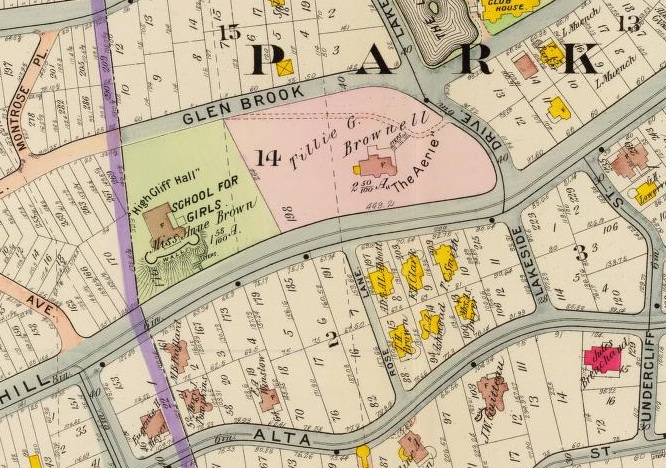

The property was owned originally by Andrew S. Brownell and his wife Matilda Gwyn Brownell
(her nickname was “Tillie”). “The Aerie” was one of the early Park Hill residences. The principals
of the American Real Estate Company, the developers of Park Hill, of which Andrew was one of them, built their homes first.
Andrew and Edwin K. Martin were principals in the American Investment Union (Andrew was president and Edwin Vice President)
which sold real estate stock to get the capital to underwrite the loans which it made to the homebuyers of Park Hill and other
developments around the US. Investors got a guaranteed 6% on their money which was secured by the land. Plus they received
a pro rata share of any profits which has averaged around 12%.Andrew was also one of the founders of the Yonkers Board of
Trade, The Park Hill Country Club, the Park Hill Association and a number of other incorporated organizations.

1869 - The Warburton Avenue Baptist Church - The magnificent $200,000 gift from John Bond Trevor and James Boorman Colgate
Wealthy
Victorians had very strong ties to their houses of worship. They believed their wealth was a gift from God and many gave back
significantly to their communities especially through their houses of worship. At that time churches were a central
part of society and socialization, so what better way to share than through their churches. This particular story had
a profound effect on the "Village" of Yonkers in 1869 and continues to play an interesting role in the "City"
of Yonkers in 2010. The two men gave the land and new building to the church with a number of conditions which are referred
to as covenants. Below is covenant #3. They wanted to insure that their gift would be forever. This condition was accepted
by the church.

Read about how the history of this church evolved from a small building on North Broadway behind the stores
that are on Warburton Avenue across the street from Philipse Manor. Read about how even when the church moved to its new location,
the original church was dismantled and repurposed into a sunday school at another location. Read about how the original location
owned by Colgate was then leased to The Womens Christian Temperance Union, a Baptist organization. The story is complex, but
a wonderful testament to the foresight of these wealthy, generous and brilliant
men.

CLICK HERE
North Broadway below Ashburton Avenue circa 1869
Below is a photo of North Broadway in Yonkers looking south. The photo was taken in the late 1860's just south of
Ashburton Avenue. On the right is the First Presbyterian Church dedicated in May of 1854. (later destroyed by fire in 1968).
On the left are stairs to various residences. Note the group of people on the left and an image of what appears to be a small
girl on the right by the fence. Exposure times for these photos were relatively long so in most cases images of people are
blurred by movement.
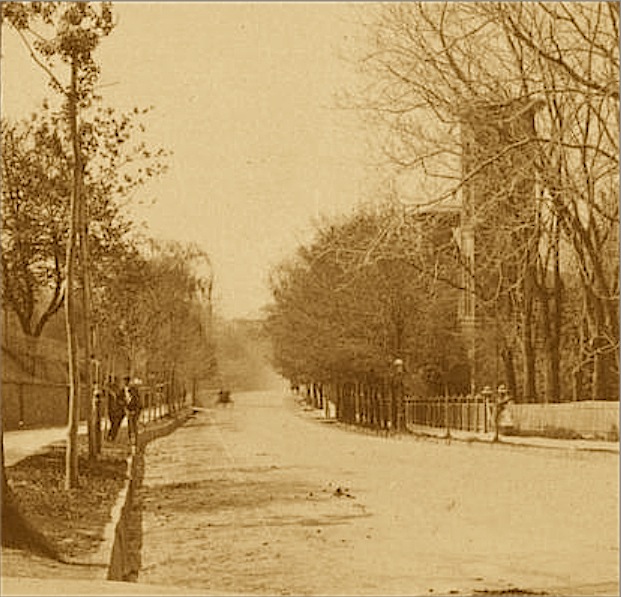
June 1894......
The
photo below was the home of Norton P. Otis on Hudson Terrace overlooking the Hudson River in Yonkers, NY photographed on a
sunny June day in 1894...One Hundred and Sixteen Years ago! His residence was aptly named "Buena Vista". He was
one of two sons of Elisha Graves Otis, the founder of the Otis Elevator Company.

The quality of this "Cabinet Card" Photo is so good that a high resolution scan allows us to
look at the family on the rear porch. Mr Otis was married in 1877 and had eight children.
